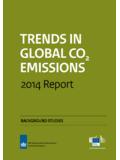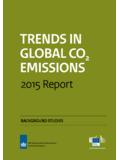Transcription of Greenhouse Gas Emissions from the Dairy Sector
1 Greenhouse Gas Emissions from the Dairy Sector A Life cycle Assessment Greenhouse Gas Emissions from the Dairy Sector A Life cycle Assessment A report prepared by: FOOD AND AGRICULTURE ORGANIZATION OF THE UNITED NATIONS. Animal Production and Health Division The country grouping (Annex 5) used in this assessment is based on the FAO Global Administrative Unit Layers (GAUL). The GAUL aims at compiling and disseminating the most reliable spatial information on administrative units for all countries in the world. Country classification is done on a purely geographical basis. For further information: The designations employed and the presentation of material in this information product do not imply the expression of any opinion whatsoever on the part of the Food and Agriculture Organization of the United Nations (FAO) concerning the legal or development status of any country, territory, city or area or of its authorities, or concerning the delimitation of its frontiers or boundaries.
2 The mention of specific companies or products of manufacturers, whether or not these have been patented, does not imply that these have been endorsed or recommended by FAO in preference to others of a similar nature that are not mentioned. All rights reserved. FAO encourages reproduction and dissemination of material in this information product. Non-commercial uses will be authorized free of charge. Reproduction for resale or other commercial purposes, including educational purposes, may incur fees. Applications for permission to reproduce or disseminate FAO copyright materials and all other queries on rights and licences, should be addressed by e-mail to or to the Chief, Publishing Policy and Support Branch, Office of Knowledge Exchange, Research and Extension, FAO, Viale delle Terme di Caracalla, 00153 Rome, Italy.
3 FAO 2010. Acknowledgements This report is a result of a collaboration between the International Dairy Federation (IDF) and the Food and Agriculture Organization of the United Nations (FAO), to assess GHG Emissions from the Dairy food chain. The analysis forms part of a wider initiative conducted by FAO to assess GHG Emissions from a range of animal food chains. We wish to acknowledge the following persons and institutions for their contributions. Study Team: Pierre Gerber (Coordinator FAO). Theun Vellinga (Lead consultant FAO/Wageningen University). Klaas Dietze, Alessandra Falcucci, Guya Gianni, Jerome Mounsey, Luigi Maiorano, Carolyn Opio, Daniela Sironi, Olaf Thieme and Viola Weiler (research team FAO). Advisory Group on methodology and data: Henning Steinfeld (Chair - FAO ).
4 Daniel Baumgartner (Agroscope Reckenholz-Taenikon Research Station ART). Sophie Bertrand (Institut de l'Elevage/ IDF). Christel Cederberg (Swedish Institute of Food and Technology). Imke De Boer (Wageningen University). Cees de Haan (The World Bank). Adrian Leip (Joint Research Centre - EC). Jean-Pierre Rennaud (Groupe Danone / IDF). Jean-Fran ois Soussana (Institut National de la Recherche Agronomique). Report preparation: Pierre Gerber, Theun Vellinga, Carolyn Opio, Benjamin Henderson and Henning Steinfeld. Thanks also go to colleagues in FAO and other institutions for their support and contributions in discussions. Particular acknowledgment is given to the Swedish Institute of Food and Technology (SIK), for its contribution to the analysis of post-farm gate Emissions .
5 Table of Contents List of Figures .. 4. List of 5. Abbreviations .. 7. Glossary of Terms .. 8. Executive Summary .. 9. Scope of this assessment .. 12. 1 14. Context .. 14. Goal of this report .. 15. 2 Methodology .. 16. Choice of Life cycle Assessment (LCA).. 16. General principles of LCA .. 17. The use of LCA within the framework of this assessment .. 17. Compliance with LCA guidelines .. 18. Functional 18. System boundary .. 19. Sources of GHG Emissions .. 21. Allocation of 22. Emissions related to land use 25. Post-farm-gate Emissions .. 26. Production systems typology .. 28. Assumptions .. 29. Emission coefficients .. 29. 3 Data .. 30. Data 30. Data 31. 4 Results and Discussion .. 32. Total Emissions for milk production .. 32. Regional 33. The partitioning of Emissions by production systems and gases.
6 35. Emissions related to land use 38. Soybean production and land use conversion .. 38. Relative contribution to farm gate 40. Post-farm gate 41. From raw milk to Dairy 41. Energy 43. Sensitivity and uncertainty analysis .. 45. Sensitivity to herd and feed characteristics .. 45. Sensitivity to manure management 46. Sensitivity to allocation 47. Uncertainty analysis .. 49. 51. 5 55. 57. LIST OF 61. Annex 1: The LCA Model - Cradle to farm 62. Annex 2: Overview of the database and data 70. Annex 3: Post-Farm Gate Emissions .. 79. Annex 4: Mitigation Options .. 89. Annex 5: Regional and Country List .. 92. List of Figures Figure System boundary as defined for this assessment .. 20. Figure Classification of cattle production systems used in the assessment .. 28. Figure Estimated GHG Emissions per kg of FPCM at farm gate, averaged by main regions and the 34.
7 Figure Relative contribution of world regions to milk production and GHG Emissions associated to milk production, processing and 35. Figure Partitioning of milk production and Greenhouse gas Emissions over livestock production systems and climatic zones .. 36. Figure GHG Emissions per kg of FPCM, by main farming systems and climatic 37. Figure Milk processing chains and related mass partition: a global 42. Figure Calculated GHG Emissions at farm gate from the processing of raw milk in selected countries and 44. Figure Sensitivity analysis: effect of a 10% change in key parameters on GHG Emissions per kg of animal protein from a Dairy system (including fattening calves) .. 45. Figure Effect of allocation techniques on partitioning of GHG Emissions between milk and meat.
8 48. Figure Sensitivity analysis: effect of protein based allocation rule on the partitioning of GHG Emissions between milk and meat .. 49. Figure Distribution of the Greenhouse gas Emissions per kg milk for Sweden, resulting from a Monte Carlo uncertainty analysis conducted on key production 50. Figure Structure of herd dynamics .. 64. Figure Average milk production per cow, by FAO-region.. 71. Figure Relationship between concentrate feed use and milk 76. List of Tables Table Summary of the allocation techniques used in this assessment .. 23. Table Overview of the data sourced for the preparation of this assessment .. 31. Table Milk and meat production and related GHG emssions global averages .. 33. Table Average annual land use change rates in Argentina, Brazil and the USA, 1990 to 38.
9 Table Relative mass and economic value fractions of oil, meal and hulls resulting from the processing of soybean .. 39. Table Trade flow matrix of soybean in 2005, expressed in percentages of total trade .. 40. Table Trade flow matrix of soybean cake in 2005, expressed in percentages of total trade .. 40. Table Percentage of raw milk transported to Dairy plant for processing in regions included in IDF reports .. 41. Table Milk processing: regional variations in mix of end 42. Table Estimated energy use and GHG Emissions for milk transport,processing and production of packaging: average values for 43. Table GHG Emissions from processing, transport and packaging for major Dairy products - average values for Europe .. 44. Table Sensitivity analysis: changes in Greenhouse gas Emissions due to changes in the manure management practice a case of 46.
10 Table Sensitivity analysis: changes in GHG Emissions due to changes in manure management a case of 47. Table Results from prior life cycle assessment studies of Dairy 52. Table Module input and output 62. Table Example of herd structure computation for the Netherlands .. 66. Table Calculated animal and management parameters, and related methane Emissions from enteric fermentation in Sweden and Nigeria .. 69. Table Animal parameters used in the assessment for Dairy cows .. 70. Table Overview of different manure storage systems used in the 72. Table Estimated manure storage systems in Africa .. 73. Table Average manure storage systems and the average percentage of nitrogen leaching from manure storage systems in the ten FAO regions .. 73. Table Estimated average digestibility of fresh and conserved grass and grass legume mixtures, by FAO regions.

















